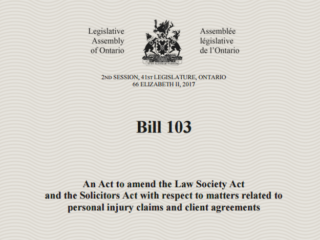At any given time across this country, there are thousands of high school students in Ontario enrolled in various Army and Sea Cadet programs, not to mention army and navy personnel operating jeeps, humvees and heavy trucks on provincial roads.
In connection with Army and Sea Cadet programs, these kids participate in potentially hazardous activities and injuries do occur from time to time. Motor vehicle accidents (MVAs) involving army vehicles also occur occasionally, and given the size of these vehicles, people on the receiving end generally lose – and not just because of the size of the vehicles involved.
The added problem for victims and their legal representatives is a little-known provision that’s quite different from the usual two-year limitation period system applied here in Ontario.
The National Defence Act (NDA) R.S.C., 1985, c. N-5 s.269(1) has definite potential to bite hard with its six-month limitation period. Section 269 reads as follows:
“Limitation period
269.(1) No action, prosecution or other proceeding lies against any person for an act done in pursuance or execution or intended execution of this Act or any regulations or military or departmental duty or authority, or in respect of any alleged neglect or default in the execution of this Act, regulations or any such duty or authority, unless it is commenced within six months after the act, neglect or default complained of or, in the case of continuance of injuries or damage, within six months after the ceasing thereof.” (emphasis added)
There are 3 avenues potentially available to deal with this punitively short limitation period.
1. Bill C-15: An Act to Amend the National Defence Act
There is in fact an Amending Act “An Act to Amend the National Defence Act” on the books, which extends the limitation period from six months to two years. The Amending Act (Bill C-15) received Royal Assent on June 19, 2013 and is the law of the land but it has not yet been proclaimed in force and reads as follows:
“Limitation or Prescription Periods, Liability and Exemptions
- Subsection 269(1) of the Act is replaced by the following:
269.(1) Unless an action or other proceeding is commenced within two years after the day on which the act, neglect or default complained or occurred, no action or other proceedings lies against Her Majesty or any person for…” (emphasis added)
2. The Crown Liability and Proceedings Act
S. 32 of the Crown Liability and Proceedings Act (CLPA) states
“Except as otherwise provided in this Act or in any other Act of Parliament, the laws relating to prescription and the limitation of actions in force in a province between subject and subject apply to any proceedings by or against the Crown in respect of any cause or action arising in that province, and proceedings by or against the Crown in respect of a cause of action arising otherwise than in a province shall be taken within six years after the cause of action arose.” (emphasis added)
Because it has received Royal Assent, the Amending Act is an “Act of Parliament” as set out in s. 32 of the CLPA: S.32 says nothing about being in force and any statute limiting a right to assert a claim will be strictly construed. It is doubtful that the court would be persuaded to read in the additional words “and proclaimed in force” to s. 32 solely to enable the Attorney General of Canada to resist a legitimate claim.
At best, the Court is left with an irreconcilable conflict between the six-month period in the NDA and the 2-year period in the Amending Act – both of which are Acts of Parliament as set out in s. 32 of CLPA. The default position for the plaintiff should become; “the limitations of actions in force in a province between a subject and a subject” per s. 32 of CLPA. Generally this would be the two-year limitation pursuant to the Ontario Limitations Act.
The rationale here is that judges are not paid to grapple with legislative non sequiturs. They are paid to interpret and apply legislation as enacted. If the legislation as enacted is incapable of being applied rationally, the court moves on to whatever legislation is workable and can be applied rationally.
3. Incidental Activites
In a recent case, an Army cadet was seriously injured in a rock-wall climbing accident. Her Commanding Officer mishandled the rope belay system and dropped the cadet 25 feet in free-fall mode, causing spinal fractures and neurological deficits. The rock-climbing activity was described as “optional” and classified as “adventure sports” by the Cadet Corps.
The courts have ruled in a number of cases that the six-month limitation applies to military or departmental activities which are public and presumably mandatory, and does not apply to “incidental” activities – i.e. optional activities that are purely incidental to the underlying military role for which the Canadian Army Cadet Corps (or Reserve Corps) was established.
If, for example, a cadet was hurt in a live-firing exercise, clearly military in nature, the “incidental activities” argument will not likely prevail. Conversely, an Army Reservist driving on duty to attend military training, who was involved in an MVA, was held by the court to be outside the purview of s.269(1) of NDA.
Many – if not most – claims involving cadet injuries, military motor vehicle accidents etc. may be more than six months old by the time they reach you. One suggestion is that you do an extremely careful analysis of the type of activity from the onset and restrain any impulse to send the claimant out the door by reason of “expiry” of the s.269(1) limitation period.
The six-month limitation, besides being harsh and transparently unfair, is inconsistent with two-year limitation periods generally in force in most provinces.
As such, you can expect the court to adopt a sympathetic posture and provide relief from s.269(1) where feasible: between the Amending Act, s.32 of CLPA and the incidental activity argument, you should be able to point the way for the court to fashion a remedy.












